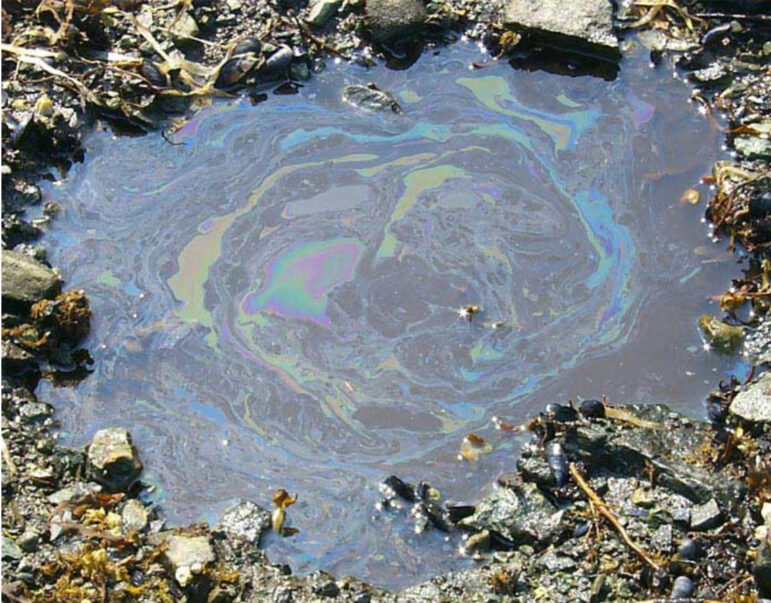This is the fourth article in the Greenwich Sustainability Committee’s “One Water” weekly series.
Written by Svetlana Wasserman, a member of the Land and Water Sector of the Greenwich Sustainability Committee.
The previous article in our series, Water in Greenwich – Too Much? Too Little? explained how our changing climate is causing more frequent flooding and droughts in Greenwich and beyond. Our water resources are shared and we share responsibility in keeping them clean and available.
How do we do that? Let’s start by noticing the problem. We’ve all seen them. Floating rainbow swirls in ponds, yellow foam in eddys, streams peppered with plastic straws, and dead fish washed up on shores. All testament to the pollution entering our waterways. How did it get there? Our first thought may be industrial drain pipes, but there is an even bigger culprit, with a clumsier name: nonpoint source pollution.

Nonpoint source pollution is the name for all pollution entering waterways indirectly–not through a pipe. It is caused by rain or snow moving man-made pollutants into our lakes and streams. It can include fertilizers and pesticides we apply to our lawns, oil and toxic chemicals from our cars and industries, soaps from car washes, sediment from construction sites, pet waste, and litter.
Rain or snowfall moves these culprits along the expressway of non-permeable surfaces–like paved streets, driveways and parking lots into storm drains, which empty directly, untreated, into our waterways. Once there, they spread. Our waterways are not isolated from one another.
All of our streams, ponds, lakes, rivers, the Sound and the ocean are connected through an
above ground and underground watershed.
Another source of water pollution is pharmaceuticals, which pass through our bodies and enter waterways. Our wastewater treatment plant was built in 1918 and was not designed to filter out pharmaceuticals. Drugs approved by the FDA are not regulated by the Clean Water Act. The impact of these biological agents–uppers, downers, hormones, painkillers and antibiotics–on our aquatic ecosystems are only beginning to be understood.
The results of all this? Pollutants impact our signature shellfish and fishing industries, erode the beauty of our coastal community, result in closed beaches, ruin the health of our delicate aquatic ecosystems and stress our water supply.
Yet each of us can play a part in reducing nonpoint source pollution right in our backyards. Reduce fertilizer use: fertilizers contain nitrogen, which stimulates plant growth. But just as the fertilizer feeds our tomatoes, it also stimulates algae growth in our waterways. Decomposing algae consumes available oxygen, leading to hypoxia–pockets of water depleted of oxygen in which fish literally suffocate. A good alternative to fertilizer is compost. Resources for making your own compost can be found here.
Avoid all pesticide use: Pesticides are regulated poisons and are harmful to any living organism that comes in contact with them. Pesticides sprayed on our garden plants end up in our waterways where they undermine aquatic life.
Replace ornamental plants with native species. Ornamental trees and plants require fertilizers and pesticides because they have not evolved to survive in our soil conditions and habitat. By choosing oaks over bradford pears, spicebush over burning bush, virginia creeper over wisteria, or milkweed over peonies you can eliminate the need for fertilizer and pesticides while providing food sources for birds and insects. Resources for finding native plants can be found here.
Reduce lawns and non-permeable surfaces. Because their roots are so shallow, lawns require heavy use of fertilizer. Take a good look at your yard. Can some of the lawn or hardscaping be replaced with beautiful flower beds or permeable hardscaping that allows the water to be absorbed by the soil? If reducing lawn is not for you, another option is to let your grass grow a little higher – 3-4 inches. Taller grass has longer, healthier roots that require less water and fertilizer. Leaving lawn clippings on the grass will also recycle nutrients back into the soil, requiring less fertilizer.
Have your septic system checked annually. Faulty septic systems can be a major source of nitrogen pollution and groundwater contamination leading to waterborne disease outbreaks. Monitor the drain field for signs of failure including odors, surface sewage or lush vegetation, and have the system inspected by a professional annually to make sure the internal structure is intact. Maintain a regular schedule of inspections and get septic tanks pumped every three to five years.
Never pour medicines down the drain or toilet. Bring unused medicines to the medication drop boxes at Town Hall or the Police Department.
Well-intentioned residents may have no idea that the way they tend to their yards has a major impact on bodies of water far from their home. But we are all connected in this web of life, through underground veins and airborne passages. Let’s be good to all our aquatic neighbors by being better stewards of our yards.
Next in our series: “Water Doesn’t Fall from the Sky–It Comes from the Soil”
See also:
Water in Greenwich – Too Much? Too Little?
April 5, 2021
Our Changing Connecticut Climate: A Water Story
March 29, 2021
One Water. Shared: Greenwich Within the Long Island Sound Watershed
March 21, 2021